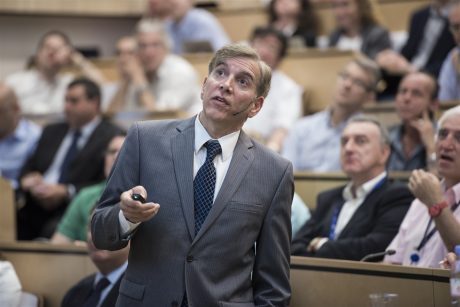


Joe Incandela
Joe Incandela is a professor of physics at the University of California Santa Barbara and currently leads the Compact Muon Solenoid (CMS) experiment at the CERN laboratory’s LHC complex near Geneva Switzerland.CMS has roughly 3,000 participating physicists from 179 institutions in 41 countries. ...
Categories
About Joe Incandela
Joe Incandela is a professor of physics at the University of California Santa Barbara and currently leads the Compact Muon Solenoid (CMS) experiment at the CERN laboratory’s LHC complex near Geneva Switzerland.
CMS has roughly 3,000 participating physicists from 179 institutions in 41 countries. CMS and its sister experiment ATLAS are the largest physics experiments ever undertaken. One of the main objectives of these experiments is the determination of the existence of the Higgs boson. On July 4 2012, Joe Incandela made the historic announcement to a worldwide audience during a press conference at CERN that a new particle resembling the Higgs boson had been discovered – “We know it must be a boson and it’s the heaviest boson ever found.”
Professor Incandela has been active in particle physics since the early 1980’s when as a graduate student he searched for magnetic monopoles with Prof. H. Frisch at the University of Chicago. He then went on to take prestigious fellowships at CERN on the UA2 experiment and Fermilab near Chicago on the CDF experiment. His work on UA2 included studies of the Z boson and one of the earliest searches for a charged Higgs boson.
On the CDF he was one of the leaders of the search for the top quark that resulted in observation of this, the most massive elementary particle ever discovered, in 1995. His interest in Higgs searches led him back to CERN and the LHC when he joined the CMS experiment in 1997.
In 2001 he joined the faculty at the University of California Santa Barbara where he led the US project to build a very large fraction of the components for the CMS particle tracking system which were delivered to CERN in 2005 then assembled into a complete tracking system and installed in 2006 and 2007.
In 2007 he became deputy Physics Coordinator and in 2010 he was appointed deputy Spokesperson of CMS. In 2011 he was elected to be the Spokesperson of the experiment.
